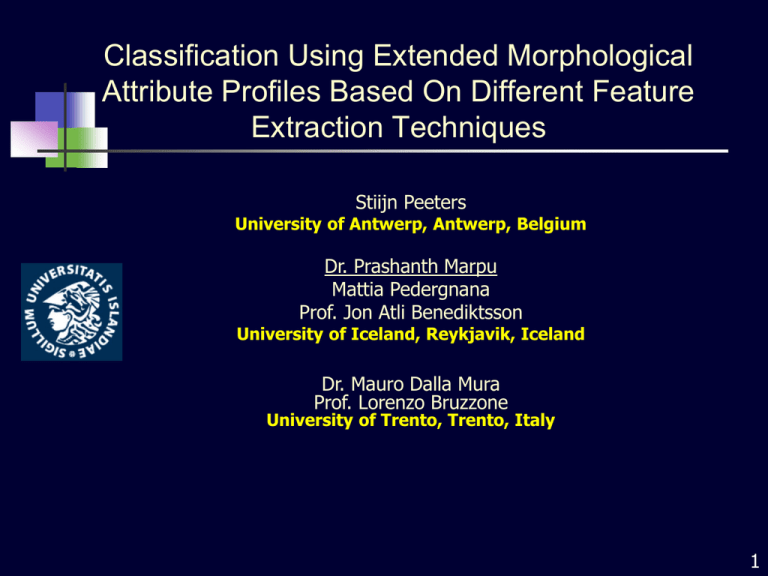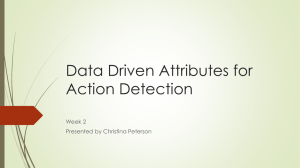k - Geoscience & Remote Sensing Society
advertisement

Classification Using Extended Morphological Attribute Profiles Based On Different Feature Extraction Techniques Stiijn Peeters University of Antwerp, Antwerp, Belgium Dr. Prashanth Marpu Mattia Pedergnana Prof. Jon Atli Benediktsson University of Iceland, Reykjavik, Iceland Dr. Mauro Dalla Mura Prof. Lorenzo Bruzzone University of Trento, Trento, Italy 1 Overview Background Morphological Attribute Profiles Classification of Hyperspectral data Ongoing work Conclusions 2 Background Morphological profiles (MP) and Morphological attribute profiles (MAP) have been successfully used to fuse spectral and spatial information for the classification of remote sensing data. J. A. Benediktsson, J. A. Palmason, and J. R. Sveinsson, “Classification of Hyperspectral Data From Urban Areas Based on Extended Morphological Profiles,” IEEE Trans. Geosci. Remote Sens., vol. 43, no. 3, pp. 480–490, Mar. 2005 M. Dalla Mura, J. A. Benediktsson, B. Waske, and L. Bruzzone, ”Morphological Attribute Profiles for the Analysis of Very High Resolution Images,” IEEE Trans. Geosci. Remote Sens., vol. 48, no. 10, pp. 3747– 3762, Oct. 2010 3 Background Traditionally, MPs and MAPs are built using the feature extraction based on principal component analysis (PCA). Moreover, the selection of filter parameters is traditionally done manually. In this study, 1. We analyse the classification results by using various feature extraction techniques (PCA, Kernel PCA, DAFE, DBFE). 2. We use a simple method to build the MAPs based on standard deviation attribute automatically. 4 Morphological Profile (MP) and Morphological Attribute Profile (MAP) 5 Morphological Profiles When dealing with real images it is difficult to identify a single filter parameter suitable to handle all the objects in the image. Perform a multilevel analysis by using several values for the filter parameters. Build a stack of images with different degrees of filtering. Morphological Profile (MP) M. Pesaresi and J. A. Benediktsson, “A new approach for the morphological segmentation of high-resolution satellite imagery," IEEE Transactions on Geoscience and Remote Sensing, vol. 39, no. 2, pp. 309-320, 2001. 6 6 Morphological Profiles Morphological Profiles (MPs) are composed by a sequence of opening and closing with SE of increasing size. Closing Profile Opening Profile MP Square SE Sizes: 7, 13, 19, 25 7 7 Extended Morphological Profile Morphological profile 1 F1 X Feature Reduction F2 MP MP MP XX111 MP XX121 Hyperspectral Image MP XX121 X MP MP EMP X1112 MP EMP XX111 Extended Morphological Profile Fn MP XX1n1 MP Morphological profile n 8 Attribute Profiles Thickening Profile Thinning Profile Square SE (MP) Sizes: 7, 13, 19 Area Attribute λ: 45, 169, 361 Criterion: Area > λ Moment of Inertia Attribute λ: 0.2, 0.1, 0.3 Criterion: Inertia > λ STD Attribute λ: 10, 20, 30 Criterion: STD > λ 9 Selection of thresholds for constructing MAP In this study, we only use the attribute profile generated using the standard deviation attribute. The thresholds to build the profile are estimated for every feature separately from the range of standard deviation values of the training samples of all the classes. So, different threshold values are used for diferent profiles. A more general approach to use a big range of attributes has been recently proposed. An entire profile using a wide range of attributes and wide range of thresholds is built and a newly proposed hybrid genetic algorithm is used for feature selection. Master Thesis: Mattia Pedergnana (University of Iceland, Iceland and University of Trento, Italy) Optimal Automatic Construction of Morphological Profiles 10 Results 11 Data used ROSIS University of Pavia 12 Data used AVIRIS Indian Pine 13 Data used ROSIS University of Pavia AVIRIS Indian Pines Training Test Corn-notill 50 1384 Corn-mintill 50 784 Corn 50 184 Grass-pasture 50 447 1815 Grass-trees 50 697 265 1113 Hay-windrowed 50 439 Shadow 231 795 Soybean-notill 50 918 Bricks 514 3364 Soybean-mintill 50 2418 Meadows 540 18146 Soybean-clean 50 564 Bare soil 532 4572 Wheat 50 162 Woods 50 1244 Bld-Grass-Trees-D 50 330 Stone-Steel-Towers 50 45 Alfalfa 15 39 Grass-pasture-mowed 15 11 Oats 15 5 Training Test Trees 524 2912 Asphalt 548 6304 Bitumen 375 981 Gravel 392 Metal sheets 14 Results: University of Pavia data PCA OA AA k SVM 92.01% 92.17% 0.8957 Random Forest OA 91.31% AA 87.96% k 0.8894 15 Results: University of Pavia data Kernel PCA OA AA k OA AA k RF 92.2% 95.02% 0.8993 SVM 92.31% 93.96% 0.9002 16 Results: University of Pavia data DAFE OA AA k OA AA k RF 96.25% 96.28% 0.951 SVM 92.69% 93.27% 0.9119 17 Results: University of Pavia data DBFE OA AA k OA AA k RF 95.09% 95.32% 0.9386 SVM 93.45% 94.16% 0.9145 18 Summary of Results University of Pavia Extended Attribute Profile using Standard deviation RF SVM PCA KPCA DAFE DBFE PCA KPCA DAFE DBFE OA% 91.31 92.2 96.28 95.32 92.01 92.31 93.27 93.45 AA% 87.96 95.02 96.25 95.09 92.17 93.96 92.69 94.16 k 0.886 0.899 0.951 0.939 0.896 0.90 0.912 0.914 19 Extended Morphological Profiles PCA RF DAFE RF DBFE RF KPCA RF PCA SVM DAFE SVM DBFE SVM KPCA SVM AA (%) 90.89 95.12 96.75 93.87 91.37 92.32 94.92 94.74 OA (%) 84.75 94.88 96.107 87.89 86.92 88.93 90.00 91.47 k 0.8048 0.9324 0.9487 0.844 0.8326 0.8579 0.8720 0.8898 Params: Initial Size: 1 Step: 2 Number Of Opening/Closing: 3 20 Results: Indian Pine PCA OA AA k OA AA k RF 92.20% 95.32% 0. 9100 SVM 88.94% 92.96% 0.8738 21 Results: Indian Pine Kernel PCA OA AA k OA AA k RF 92.87% 96.01% 0.9183 SVM 88.93% 93.36% 0.8737 22 Results: Indian Pine DAFE OA AA k OA AA k RF 77.21 % 87.62 % 0.7427 SVM 68.70% 71.31% 0.6464 23 Results: Indian Pine DBFE OA AA k OA AA k RF 81.28% 87.78% 0.7866 SVM 73.13% 79.81% 0.6954 24 Summary of Results Indian Pine Extended Attribute Profile using Standard deviation RF SVM PCA KPCA DAFE DBFE PCA KPCA DAFE DBFE OA% 92.20 92.87 77.21 81.28 88.94 88.93 68.70 73.13 AA% 95.32 96.01 87.62 87.78 92.96 93.36 71.31 79.81 k 0.910 0.918 0.743 0.787 0.874 0.8737 0.646 0.695 25 Extended Morphological Profiles PCA RF DAFE RF DBFE RF KPCA RF PCA SVM DAFE SVM DBFE SVM KPCA SVM AA (%) 93.54 87.67 86.69 95.66 92.90 69.84 78.93 92.702 OA (%) 87.75 79.08 78.98 92.01 87.15 66.61 71.36 86.67 k 0.8607 0.7627 0.7615 0.9085 0.8533 0.6231 0.6763 0.8483 Params: Initial Size: 1 Step: 2 Number Of Opening/Closing: 3 26 Conclusion The results of classifying hyperspectral data using morphological attribute filters with various feature extraction techniques has been studied. Better results are obtained with attribute profiles compared to morphological profiles. Supervised feature reduction techniques are constrained by the number of available samples and hence do not provide consistent results. Linear unsupervised feature reduction techniques such as PCA may not be useful as the features are not always able to distinguish between classes effectively. This is observed in the experiments. 27 Conclusion However, non-linear techniques such as kernel PCA preserve the information of the independent clusters and hence can be useful in distinguishing between classes. Experiments suggest that EAP with KPCA produces consistent and high quality classification results. We are currently investigating the results with a wide range of feature extraction techniques. We are also working on methods to automatically identify the thresholds to build profiles. 28 Experimental Results Pavia Dataset – Second Approach – HML-DBFE-RF Overall Accuracy: 98.3% Average Accuracy: 98.6% 29 29 Experimental Results Pavia Dataset – Second Approach – HML-KPCA-RF Overall Accuracy: 90% Average Accuracy: 97 % 30 30 Experimental Results Pavia Dataset – Second Approach – HML-KPCA-SVM Overall Accuracy: 93.8% Average Accuracy: 96.9 % 31 31 Experimental Results Indian Pine– Second Approach – HML-KPCA-RF Overall Accuracy: 93.8% Average Accuracy: 96 % 32 32 Software in Matlab can be freely obtained by sending us an email. Prashanth Marpu prashanthmarpu@ieee.org Mattia Pedergnana mattia@mett.it Mauro Dalla Mura dallamura@disi.unitn.it Thank You for your attention 33









